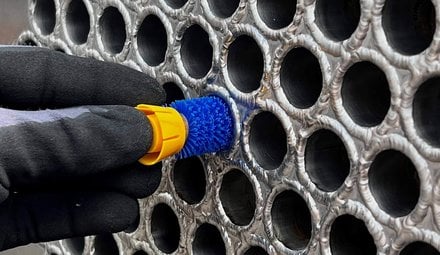
Projectile Tube Cleaning
Cleaning with projectiles
Low-pressure cleaning with projectiles is one of the fastest methods to clean the tubes of (larger) shell-and-tube heat exchangers and condensers. The equipment is simple and safe to use. A propulsion system shoots special projectiles through the tubes within seconds. These projectiles remove deposits from the tube wall by scraping it off. This immediately improves the heat transfer and thus the efficiency of the heat exchanger, without the risk of damaging the tubes. Projectiles are selected based on various factors such as the material of the tubes and the type of fouling.
Check out the rotary tube cleaning technology for smaller heat exchangers.
Applications industry
Cleaning shell-and-tube heat exchanger tubes with projectiles is relatively easy to do. In addition, this technique is safe for the operator and the installation itself. The chance of damaging tubes is virtually impossible, especially with the polyethylene and nylon projectiles. This technique is particularly interesting for the following systems/installations:
- (Steam) surface condensers of power generation plants
- Large water-cooled chillers
- Process shell and tube heat exchangers with 500 tubes or more
- Air fin coolers
Utilizing the technology
Goodway projectile tube cleaning systems are mainly used for larger tube heat exchangers with 1000+ tubes. Because a projectile tube cleaning can be rapidly carried out, the cleaning time can remain short, even with large surface condensers that contain tens of thousands of tubes. In general, this technique works best with soft to medium type deposits, but it is also possible to remove harder deposits such as limescale. Below, you will find the most important features of this technique:
- For tubes with internal diameters between 12,6 - 31,75 millimeters.
- Can be used for any tube length.
- Various projectiles available for every type of deposit and tube material.
- Safe for titanium and Cu/Ni tubes material.
- This technique offers significant improvements in terms of safety, speed, costs and water consumption.
With the projectile tube cleaning technique, you can remove different types of deposits. Below you will find the most common types of deposits that can be removed with Goodway projectiles:
- Silt, algae, slime (biofilm), sand, mud, sludge, zebra mussels, barnacles, and limescale
Attention: Heat exchanger tubes with very hard deposits that require (ultra) high pressure cleaning (2000+ bar) are not a good match for this cleaning method. A projectile tube cleaning can be performed after the initial cleaning to remove any leftover deposits.
Advantages projectile tube cleaning
A projectile tube cleaning offers a number of other advantages. In many cases, this technique is safer, faster and more efficient than traditional cleaning with, for example, high pressure lancing. Below you will find a brief summary of the main benefits:
- Speed: the time saved when cleaning with projectiles is substantial. First, you flush the tube without a projectile. This is done to check whether there is a blockage and to pre-rinse the tube. Afterwards, you load the projectile into the tube and shoot it through. This entire process takes less than 10 seconds, regardless of the length of the tube.
- Water consumption: The QS-300 uses compressed air and water in a 90/10 ratio. This means that only 10% water is used. The QS-300 uses approximately 18–20 liters of water per minute. Divided over a number of tubes, this results in a very low net water consumption per tube. The BFP system uses 132 litres/minute, but you only need about 10 seconds per tube. This amounts to approx. 20–25 liters of water per tube. This is a significant reduction compared to other cleaning techniques.
- Safety: the system uses a low pressure technology. This makes the cleaning process a lot safer for the operator. In addition, the tubes remain intact and undamaged, because they are not exposed to (extremely) high pressures.
- Lower costs: Goodway propulsion systems are very affordable and therefore represent a relatively low investment, even if several are purchased at the same time. After that, you only need projectiles that can be purchased on a project basis or for a specific type of heat exchanger. Projectiles can be reused, further reducing variable costs.
Customer Service
If you need further assistance, please contact our customer service to discuss the possibilities and options. You can of course always chat with our employees by starting the chat function at the bottom right of your screen!


